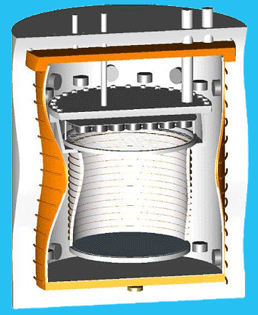Overview
XENON is a next-generation Dark Matter Direct Detection experiment, which will
use liquid xenon as a sensitive detector medium to search for WIMPs (Weakly
Interacting Massive Particles). These particles, postulated by Super Symmetry
(SUSY), are believed to have a mass in the neighborhood of 100 GeV, to ignore
Electromagntic Interactions, and to permeate the Universe.

XENON plans to probe the lowest SUSY parameter space, with a sensitivity of 1 event/100 kg/year. The project is funded by the National Science Foundation for a Phase I study. Development and support of a US National Underground Laboratory and a strong worldwide collaboration will make XENON one of the most promising dark matter searches.
A schematic representation of the XENON design is shown above. An array of 10 such position-sensitive liquid xenon time projection chambers (LXeTPC) will make the detector a tonne-scale experiment. Each TPC will comprise 100 kg of active xenon mass, and be self-shielded with additional LXe.
A modular approach is preferred over a single detector for several reasons. The most important is simply a feasibility argument: we have already built a 30 kg LXeTPC and have used it for several balloon fights of the Liquid Xenon Gamma-Ray Imaging Telescope (LXeGRIT).
The experience gained through this development effort, and the prior years of R&D on noble liquid detectors, give us the confidence that a 100 kg TPC optimized for dark matter detection can be built successfully. With an array, a failure of one module would not halt the entire experiment. Operational effciency is clearly higher than with a monolithic detector of 1-tonne.

XENON plans to probe the lowest SUSY parameter space, with a sensitivity of 1 event/100 kg/year. The project is funded by the National Science Foundation for a Phase I study. Development and support of a US National Underground Laboratory and a strong worldwide collaboration will make XENON one of the most promising dark matter searches.
A schematic representation of the XENON design is shown above. An array of 10 such position-sensitive liquid xenon time projection chambers (LXeTPC) will make the detector a tonne-scale experiment. Each TPC will comprise 100 kg of active xenon mass, and be self-shielded with additional LXe.
A modular approach is preferred over a single detector for several reasons. The most important is simply a feasibility argument: we have already built a 30 kg LXeTPC and have used it for several balloon fights of the Liquid Xenon Gamma-Ray Imaging Telescope (LXeGRIT).
The experience gained through this development effort, and the prior years of R&D on noble liquid detectors, give us the confidence that a 100 kg TPC optimized for dark matter detection can be built successfully. With an array, a failure of one module would not halt the entire experiment. Operational effciency is clearly higher than with a monolithic detector of 1-tonne.
